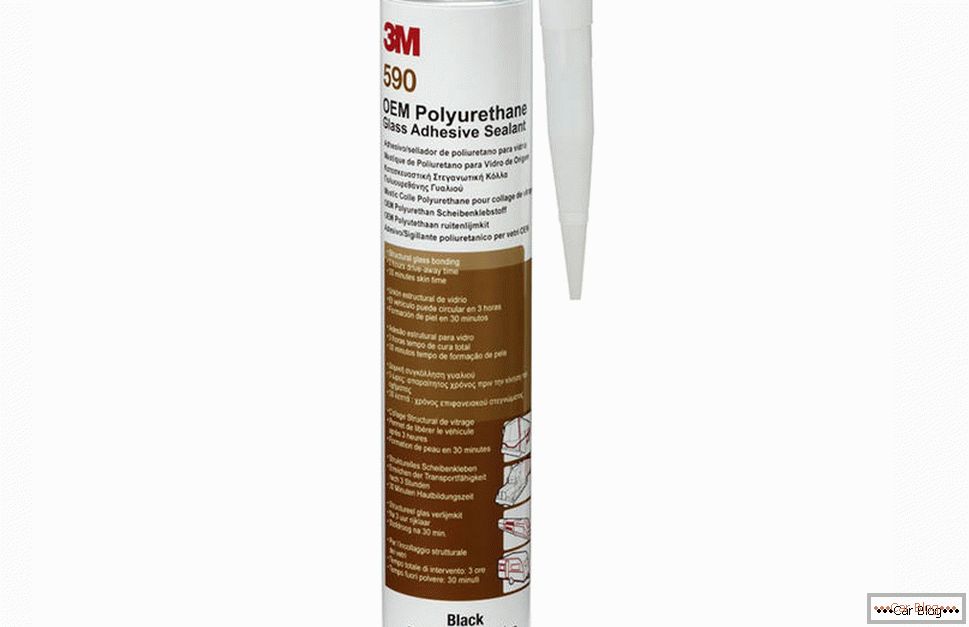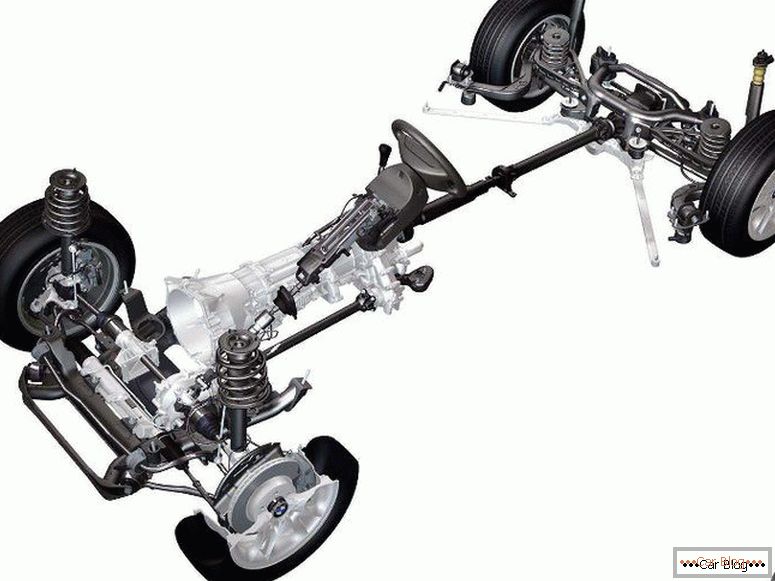>
Despite the fact that the windows in the car are made of very durable material, they are still a high risk zone in any car. Even a small pebble that has flown out from under the wheels of an overtaking or oncoming vehicle can destroy the integrity of the windshield. Today's triplex is practically not at risk of scattering into pieces, but any crack will inevitably lead to further glass breakdown over time, and it will be impossible to stop this process. It is safe to say that approximately every second driver has encountered a situation requiring replacement of glass. Financially, it is quite expensive: the cost of front and rear glasses is decent, but the master will have to pay as much, if not more, for the work. Therefore, many car owners prefer to perform this operation on their own - the replacement technology itself is fairly simple. The only catch is the choice of glass sealant for cars. If thirty years ago mainly epoxy adhesives were used for this, now the market offers a considerable number of more technologically advanced compositions, characterized by improved adhesive, strength, temperature and other characteristics. The purpose of this review is to acquaint the reader with the varieties of adhesives for automotive glass, to give a general idea of how to use them, and to give a rating of the best sealants on the Russian market.
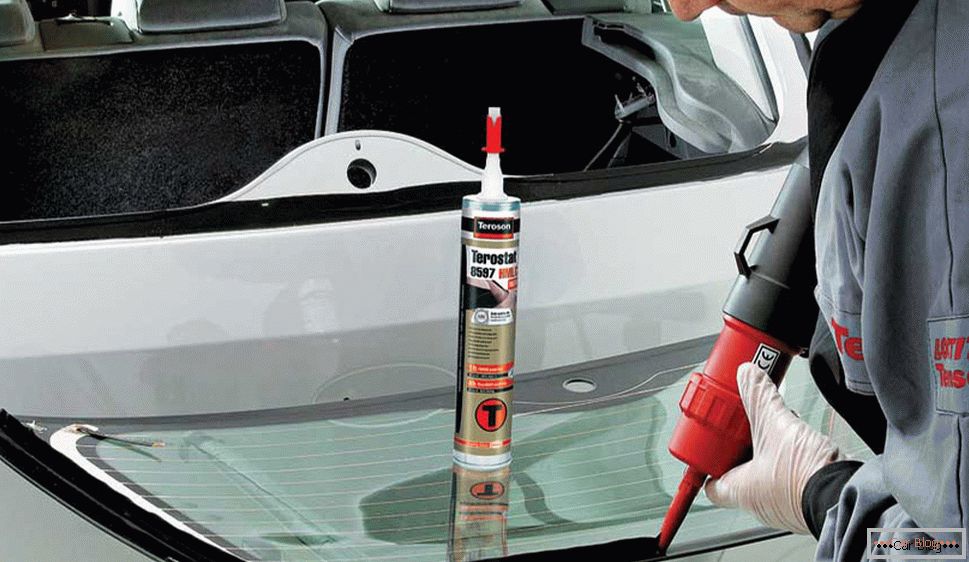
Features of the choice of glue for automotive glass.
Читать далее про то как правильно выбрать клей для автомобильного стекла-->
Varieties of adhesives for auto windows
If you have never tried to replace damaged glass yourself, you will probably have many questions regarding the technology of this procedure. But among the first to consider the problem of choosing the most suitable adhesive composition. The main thing - not to succumb to the temptation and advice of the same "professionals" and not to use universal adhesives, characterized by instant (or almost instantaneous) gluing. The fact is that such adhesives, as a rule, are intended for joining surfaces that are not subjected to dynamic loads. A car in this respect is an inappropriate field for experimentation. Vibration, mechanical shocks and jolts, temperature fluctuations and changes in humidity — all of these factors do not contribute to high-quality retention of glass glued to instant-on compositions. The glass will inevitably begin to peel off, and this already threatens to destroy it.
Therefore, it is important to use only two-component adhesives designed specifically for automotive glass. Moreover, their choice is huge, and the cost is quite affordable. Structurally frontal and rear windows play not only a protective role, protecting the driver and passengers from external influences - they are an integral part of the vehicle security system, playing a certain role in providing the necessary body rigidity. And of great importance in this and the adhesive composition, which acts as a kind of elastic layer between the body elements and glass. Adhesive sealant for automotive glass is of two varieties, each of which carries a certain functional load:
- adhesive composition intended for the installation of glass itself;
- glue to eliminate minor defects (chips and cracks formed during the operation of the vehicle).
The first category provides a reliable connection of the glass to the seat with giving the intermediate layer sufficient elasticity to withstand the deformation effects from the body. If the damping properties of the sealant are not high enough, due to insufficient depreciation in jolts and impacts, the probability of cracking increases significantly. Therefore, it is important to choose an adhesive that has all the necessary characteristics.
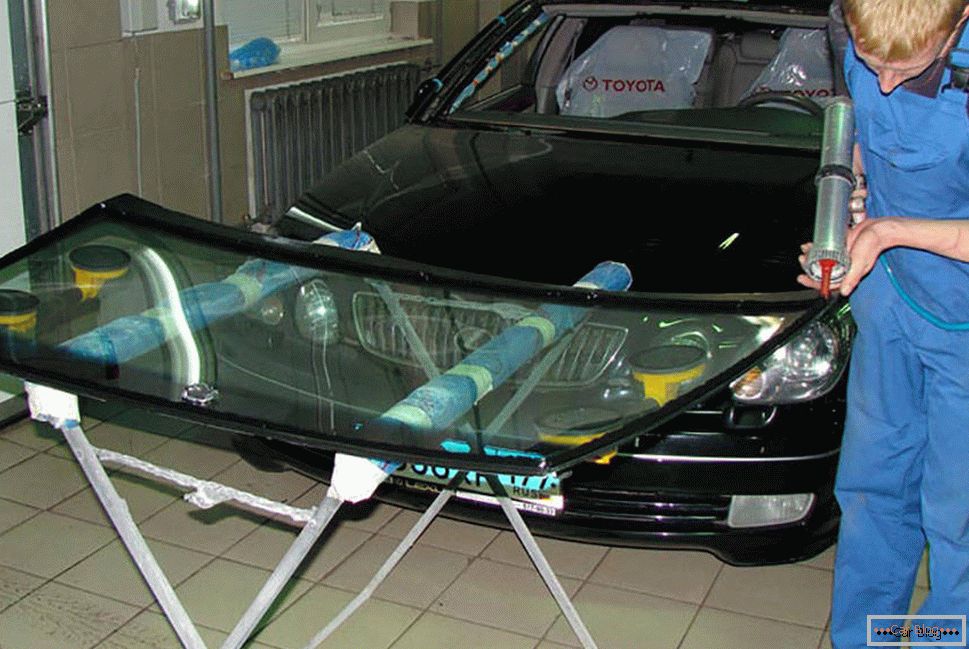
Glue mixes for mounting glass
Most modern automotive mounting adhesives for installing windshields are made of a material based on polyurethane components. Possessing excellent connective properties, this material provides both the required strength and the desired elasticity. In addition, as a result of polymerization, such a sealant acquires the ability to withstand significant temperature differences. The hygroscopicity of the composition is minimal, so this compound is also not afraid of high humidity. The only drawback of polyurethane adhesive materials is the fear of ultraviolet radiation. With prolonged exposure to direct sunlight, the polymer eventually loses its characteristics. It is not by chance that the “correct” technology of glass gluing involves applying a special protective layer on them that protects the sealant from ultraviolet radiation. This technology, called screen printing, is used on most new cars.
To ensure the required strength characteristics of the compound, adhesive-sealant must be applied, adhering to certain rules. In particular, before applying it you need to thoroughly clean the surface from the remnants of the previous glue. Polyurethane adhesive should not be applied to metal areas covered with rust or to places with bitumen residues. Of great importance is the rate of hardening of the adhesive mixture. It should be understood that slow-hardening mixtures are considered more reliable, because with a longer polymerization process, stronger seams are formed. So the choice of “fast” compositions is not always justified - if the time factor is not critical, preference should be given to sealants with a long hardening time. But when using such mixtures, it is necessary to ensure the most stable external conditions. If it is difficult or impossible to achieve constant humidity or temperature - in this case, you need to choose a quick-drying glue for the windshield of the car.
Car Glass Sealers
The range of sealants for car glass repair is extensive - there are many brands of domestic and foreign production on the market. Their performance may vary widely depending on the following parameters:
- polymerization rate;
- degree of adhesion;
- strength of seams;
- elasticity;
- ability to withstand mechanical stress;
- resistance to external destabilizing factors (high humidity, temperature extremes).
It depends on the elasticity of the composition of the sealant how comfortable it will be to work with it, whether it will stretch strongly and will not form streaks. Grinding of the treated surfaces is not required - it is enough to clean the metal and glass from foreign inclusions sufficiently and degrease them. When working with polyurethane compounds it is necessary to observe security measures - the composition of the adhesive-sealant may include toxic components. Pay attention to the working temperature of the adhesive composition - the polymerized joint must retain its properties both in frost and at a temperature of about 120º C. When choosing a sealant, pay attention to the following circumstances:
- You should not buy an adhesive composition from an unknown manufacturer - it is quite possible that it corresponds to the declared characteristics, but the probability of poor quality of such products is very high. Let the glue from a well-known brand is more expensive, but in this case you are protecting yourself from acquiring a deliberately low-quality product.
- A certificate of conformity will be an additional advantage, since it guarantees the full compliance of the characteristics of the adhesive indicated on the label with the actual.
- Check with the seller if you need to buy any additional components when applying the adhesive you like.
- Decide in advance on how much time will be required for polymerization, and select the sealant in accordance with this indicator.
- The elasticity of the adhesive must be sufficient to compensate for the expansion processes with temperature drops and external mechanical effects.
- The strength of the seam should also be so high as to ensure the safety of the driver and passengers against the risk of injury due to glass crash.
- A sealant with a satisfactory modularity index should be chosen - this parameter dampens the vibration loads that occur when the vehicle is moving.
- The electrical conductivity of the polymer seam should be close to zero - this will protect the driver from parasitic / static currents.
Glue mixes for eliminating defects of car windows
The adhesive sealant used for minor repairs of automotive glass differs radically from the polyurethane compositions used for installation in a number of parameters. The main criterion taken into account in its production is the color / optical identity of the glass itself, which is subject to repair, and the polymerized adhesive. But if the manufacturers coped with this task, then the buyer will have to rely heavily on intuition, since it is impossible to determine in advance the compliance of the adhesive mixture with the color of glass. For a repair variety of adhesive compositions, the cushioning properties are not needed; therefore, such a composition should provide higher strength and less ductility compared to the polyurethane variety. It should also be noted that the brittleness of the polymerized layer is quite high (at the level of the glass itself). As a basis for the manufacture of repair glass adhesives, polymeric resins are used, which differ in their physical and chemical properties from polyurethane compounds. In particular, for the solidification of such a sealant requires the presence of ultraviolet rays of the spectrum, which are detrimental to polyurethane analogues.
The strength of the adhesive for repairing cracks after complete polymerization is so high that such a seam can be polished using special polishing pastes. Another distinctive characteristic of repair adhesives is their increased resistance to moisture and temperature differences — according to this indicator, the polymerized layer approaches the characteristics of glass. This refers to such indicators as the optical transparency of the material, the refractive index of the light beam, resistance to color change. Manufacturers of automotive chemicals offer adhesive compositions for the repair of windshield defects in both single-component and two-component composition. In the latter case, when mixing the two parts, the manufacturer’s requirements should be strictly followed.
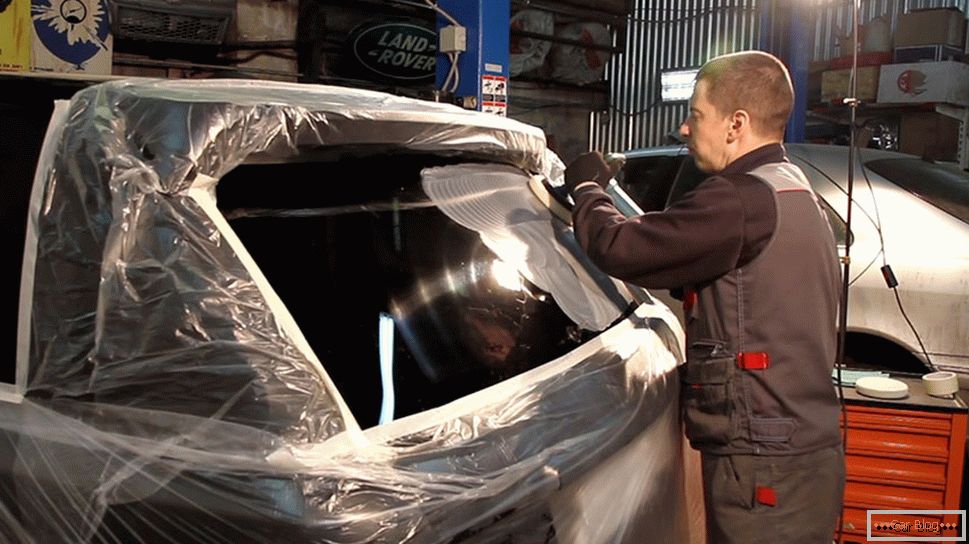
Algorithm for the use of adhesive sealant
When they talk about passive safety, they primarily mean seat belts and pillows. But the windshield is also an element of the car's security system, and in many tests its durability indicator is included in the final grade. Therefore, it is so important when replacing glass that you strictly follow all the required procedures. Since there are quite a few varieties of polyurethane adhesives, let's take one of the most popular Henkel Teroson sealants as an example:
- The first stage is the dismantling of the damaged windshield. It helps to keep the decorative elements that need to be removed, then, using special wire or sharp knives, you need to cut the existing seam, observing extreme caution. After that, the windshield can be removed.
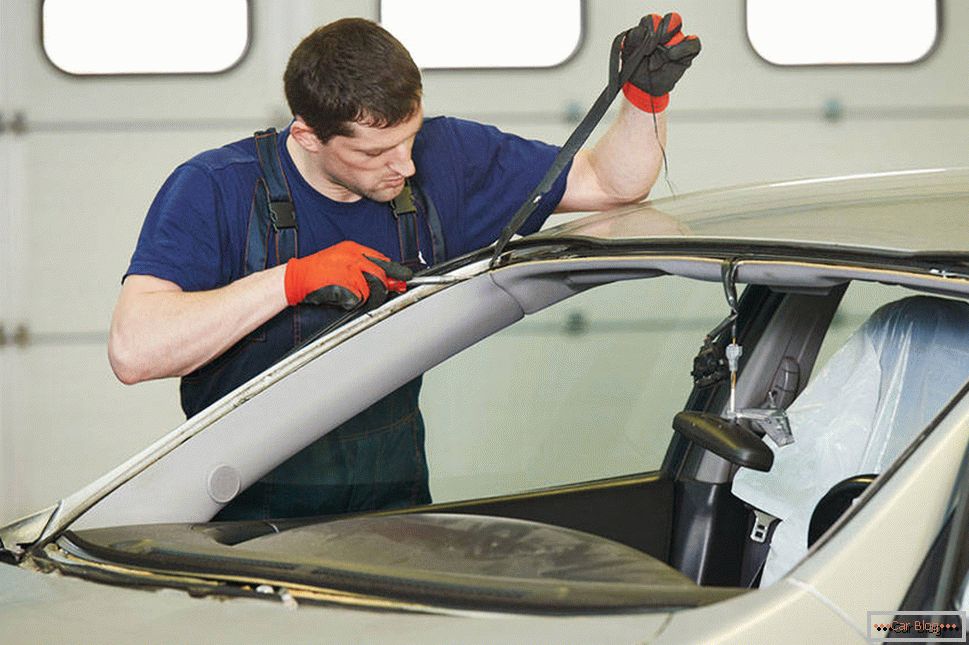
 Discounts for new cars! Profitable loan from 9.9% installments 0%
Discounts for new cars! Profitable loan from 9.9% installments 0%  adom.ru
adom.ru - New glass also needs to be prepared. To do this, in places where the polyurethane adhesive composition is applied, it must be cleaned using cleaners. It is desirable that they were from the same manufacturer as the adhesive sealant itself.
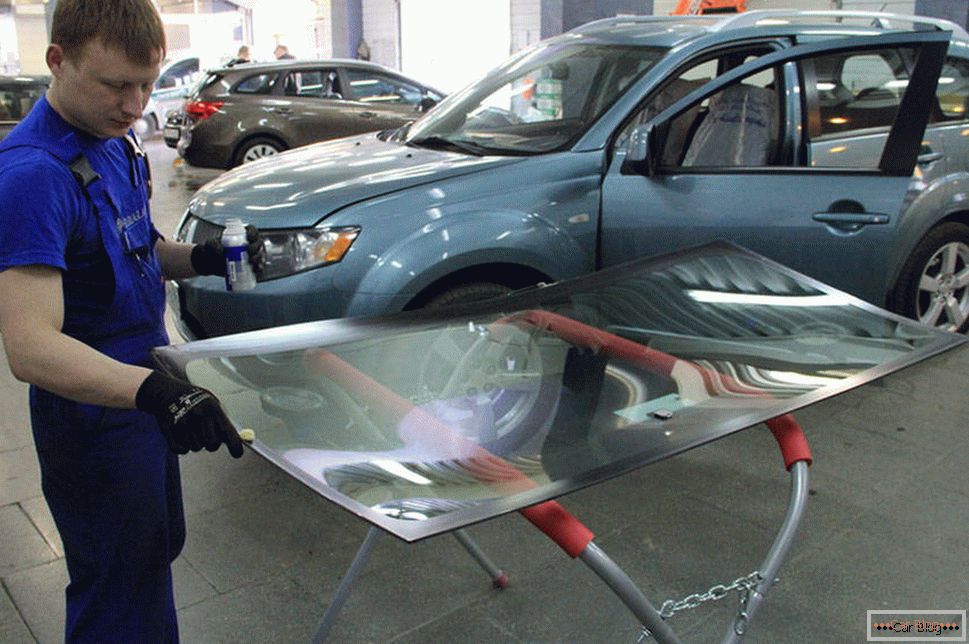
- Do the same with the surface of the body to which the glass will be attached. The most time consuming process is removing the old sealant, after which it should be restored if there is any damage to the paintwork. Finally, the treated surface is cleaned of dirt and dust and degreased.
- The next stage is preparatory. Many polyurethane adhesives should be reheated before application. This also applies to Teroson glue. This is done using a special heater, and if it is absent, you can replace it with any vessel filled with water, in which you place the tube of glue.
- Of course, the application of glue - the most crucial moment. It should be applied either on the body or on the glass (the second method is preferred by most beginners). In this case, special attention should be paid to ensure that the glue strip is as uniform as possible along the entire perimeter.
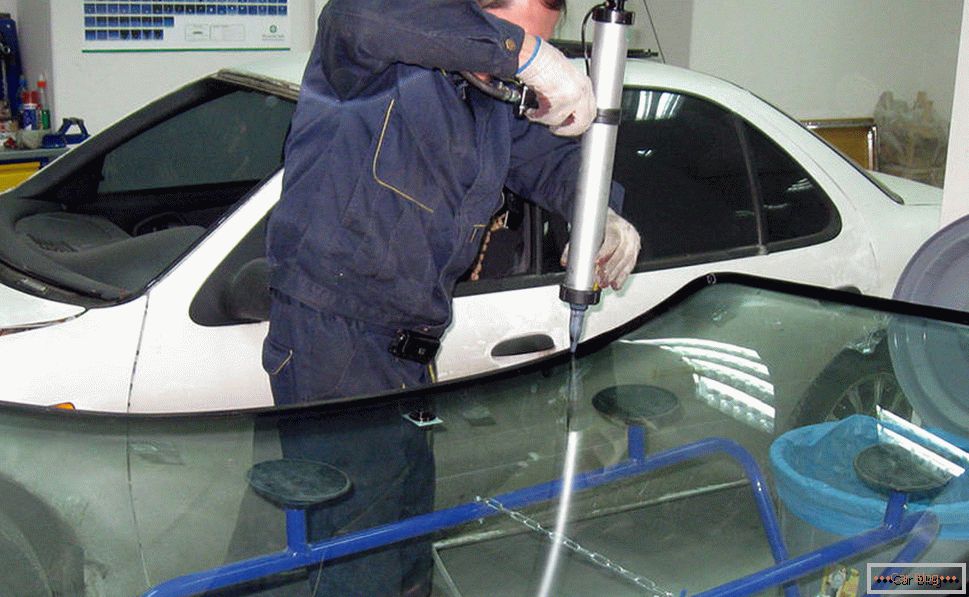
- Glass installation is a procedure that must be performed immediately after the application of the adhesive composition, since in most cases the polymerization rate is very high. If you delay with this, the viscosity of the sealant may be too high and the quality of the seam will suffer.
- Polymerization of adhesive sealant does not require any action other than waiting. For Henkel Teroson glue, this is 1 hour for cars that are not equipped with airbags. Otherwise, you need to wait 2 hours, and during this time the car must be in a stationary state.
As soon as the manufacturer’s recommended waiting time for full polymerization has passed, the car can be operated, but it is advisable to limit the movement speed to 50–60 km / h for a few hours.
Rating of adhesive compositions for the installation of automotive glass
Above, we have considered in some detail the factors influencing the choice of adhesive-sealant. Now it's time to get acquainted with the compositions that have proven their professional suitability for the category of cars.
SikaTack-Drive
The manufacturer of this composition is the American company Sika Corporation, whose production facilities are located in New Jersey. This is not only a well-known, but also a fairly experienced manufacturer of automotive adhesive materials that has been present on the market since the 80s. The quality of the company's products is evidenced by the fact that it is the official supplier of glass sealants for a number of world-class automakers - Daimler, VW Group, BMW, General Motors, Volvo, Ford, PSA concern. SikaTack-Drive adhesive refers to products intended for the repair / maintenance of passenger cars representing the aftermarket. A feature of this and other adhesives is versatility: the concept of a single module involves the use of sealants for all types of vehicles for individual use.
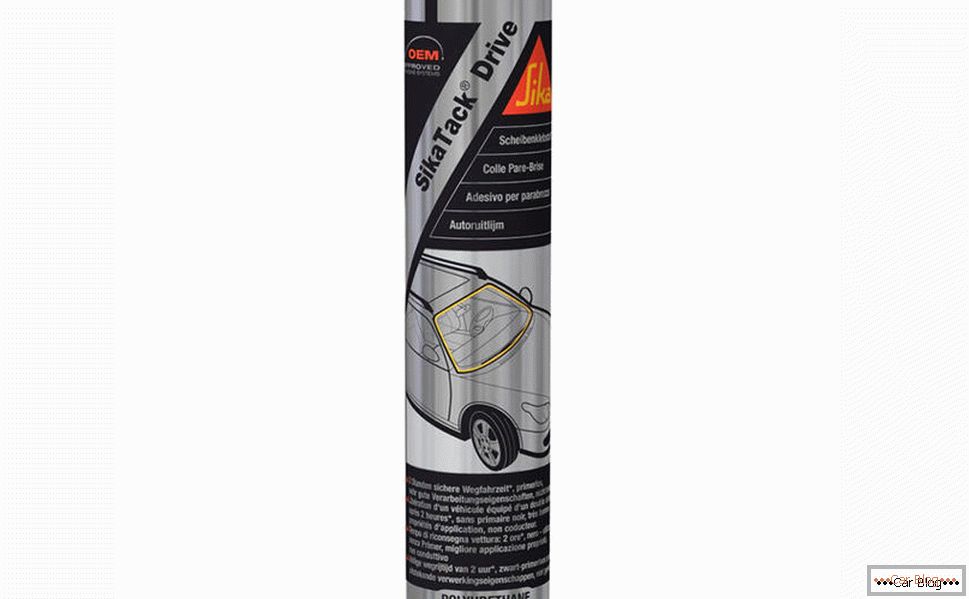
SikaTack-Drive is popular with many domestic glass installers. The composition has proven itself from the best side, it is characterized by good elasticity, it is not flowable and holds the adhesive layer perfectly when applied, without forming streaks. Does not require the use of primers and has a polymerization time of about 10 minutes. It is safe to say that Sika sealant for the windshield of the car is considered the best representative in this category of adhesives. Other adhesive characteristics:
- single component composition;
- available in 310 ml cartridges;
- can be used without the need for heating;
- Apply glue to a temperature of 20 - 22 ° C;
- the time from application to the possibility of operating the vehicle is 40 minutes for a car without a safety regulations and 4 hours for a vehicle with an airbag.
3М Windo-Weld SuperFast Urethane
There is no need to represent the American company 3M - its history goes back more than a century. And although the range of its products is extremely extensive, there was also a place for adhesive automotive compounds, one of the best representatives of which is Windo-Weld SuperFast Urethane sealant. Supplied in cartridges of 310 ml., Licensed by Nascar for racing cars participating in the series of the same name. Adhesive Specifications:
- polymerization time (from the moment of application to the installation of glass) - 15 minutes;
- one-component composition that does not require preheating;
- the time from application to the possibility of operating a vehicle without PB is 3 hours, and a strength of about 50 p.s.i is achieved;
- time of sludge of a car equipped with airbags is 8 hours, while the strength of the seam has time to reach 150 p.s.i
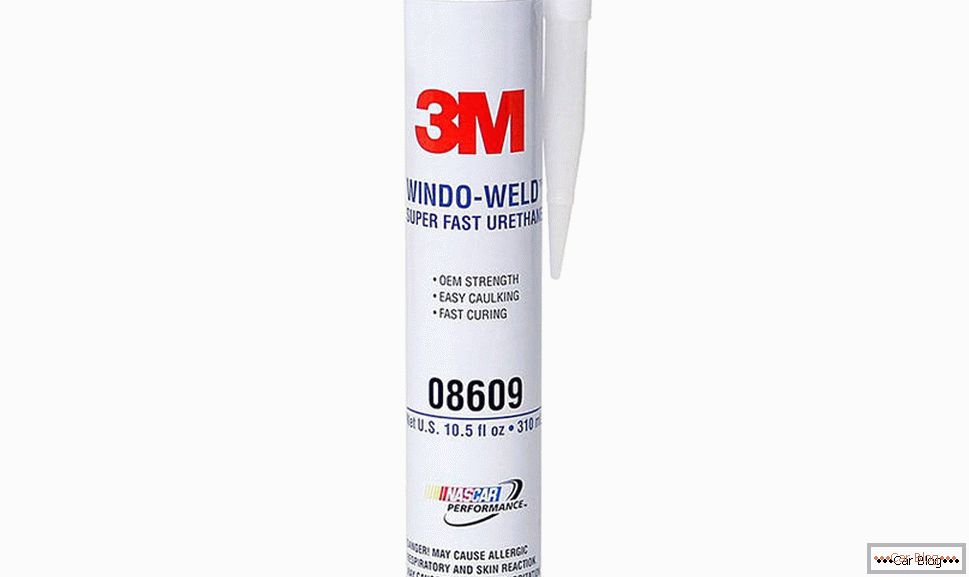
Dow Automotive Betaseal 1527
Dow Automotive is not well known to the Russian consumer, which cannot be said about its parent concern Dow Chemical, which is the world leader in the development and production of polyurethanes and other synthetic materials. Dow Automotive, being a subsidiary of the chemical concern, specializes in the production of adhesive compositions for the installation of automotive glass and adhesives for the repair of glass. The Betaseal brand is an adhesive system, produced both in the United States and in the European division of Dow Europe GmbH, located in the Swiss city of Freienbach. Products represented on the Russian market are manufactured in Europe. Polyurethane adhesive sealant Betaseal 1527 is a rather unique product, since it is used both as an OEM adhesive and as a sealant widely used in the secondary market.
It is characterized by a very short sludge time (for cars not equipped with airbags - 1 hour). Glue is easy to use, can be applied in a wide range of temperatures, including low ones. It is considered a universal adhesive suitable for any car brand. Among the drawbacks is the presence of a primer, which, together with the cleaner, is included in the delivery. Despite not it, it is considered one of the best glues for autoglasses. Features Betaseal 1527:
- the time from application of the composition to the start of polymerization is 12 minutes;
- readiness for operation of the car - 60 minutes;
- the dielectric characteristics of the polymerized product provide a steady reception of radio signals, satellite navigation signals and cellular telephony;
- high modulus formula allows to ensure the highest strength of the seam even in case of an accident;
- Betaseal 1527 is fully compliant with industry standards and international safety requirements / regulations.
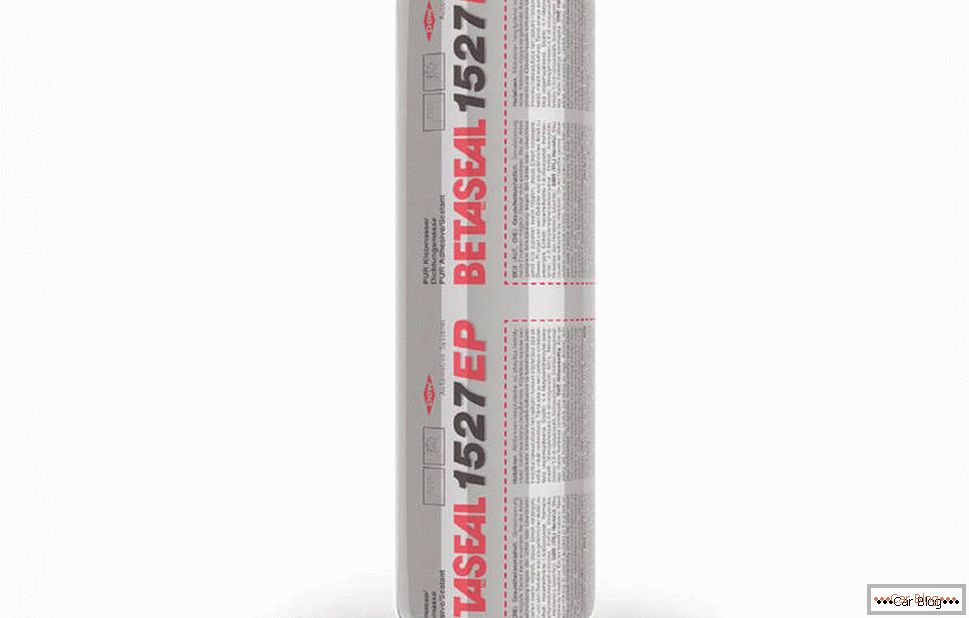
Dow Corning 7091
Another representative of a subsidiary of the concern Dow Chemical. Glue structure of Dow Corning 7091 is one-component silicone sealant, completely ready to the use. It can be used both for gluing glass and in body repair - it holds metal and plastic equally well. It is characterized by excellent elasticity and not less high strength, it hardens quickly enough. The operating temperature of the polymerized composition is from minus 55 to plus 185 degrees. It is supplied in several packaging options - in cartridges with a volume of 0.31 l., A 20-liter container and barrels (250 kg.). The last two options are for auto services. 310 ml tube. It costs about 800 - 850 rubles.
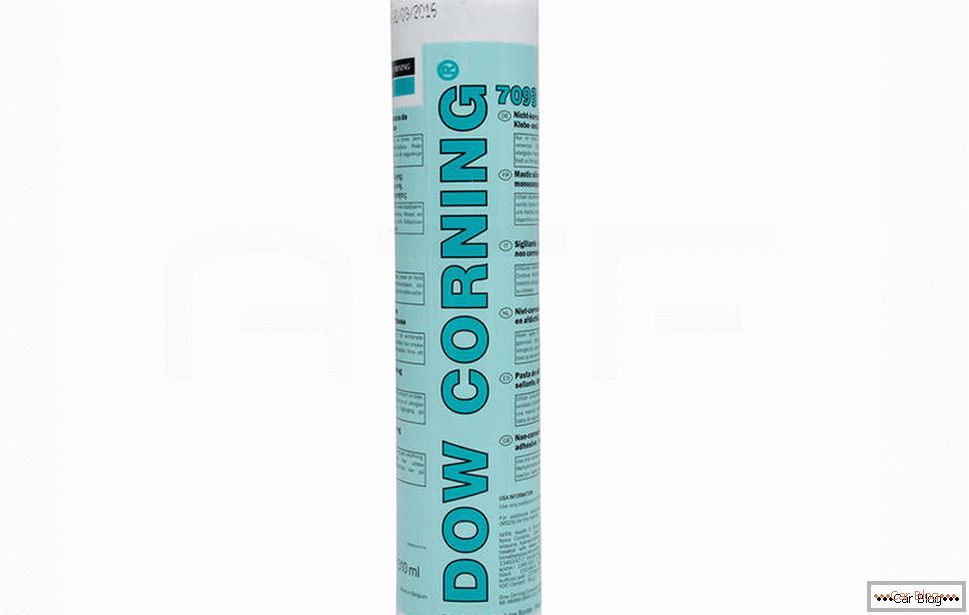
Эфиматика РВ
Polyurethane one-component adhesive sealant, manufactured by the famous French chemical concern. It is characterized by high durability of the polymerized seam, does not smell, is applied easily, holds the form and does not spread. The total polymerization time is 30 minutes. On sale it is found in tubes of 300 or 600 grams, the cost of glue in a smaller container is around 500 rubles.
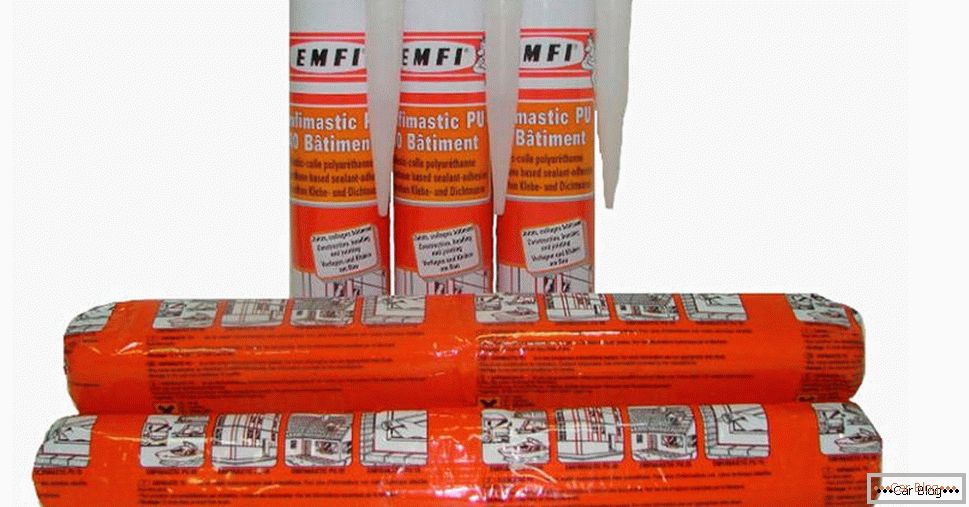
3M PU 590
Another product from 3M, characterized by versatility (the ability to glue virtually any surface). The polymerization time of the polyurethane one-component composition is 25 minutes for cars without PD and 40 minutes for cars equipped with cushions. Among the shortcomings it is worth noting the possibility of cracking at temperatures over 100 ° C. Like the previous adhesive sealant, it is packaged in 300 and 600 g tubes, the cost of 300 grams leaves 460 - 550 rubles.
